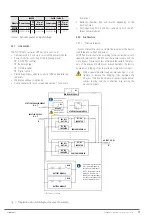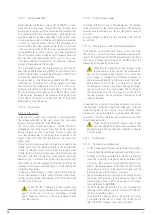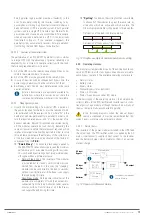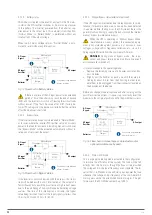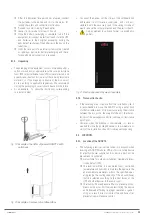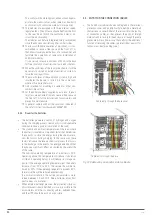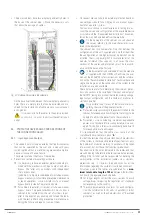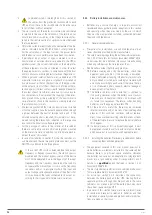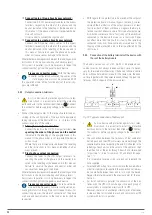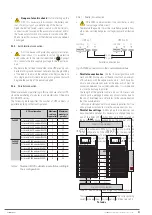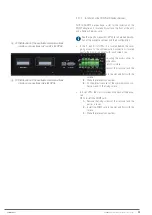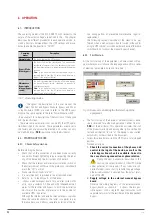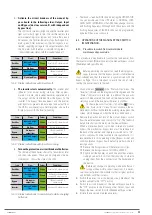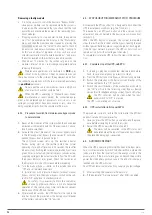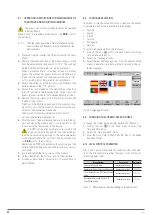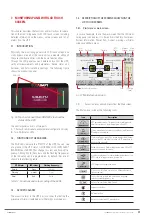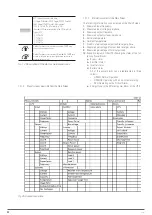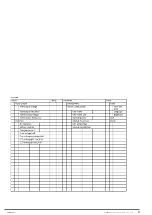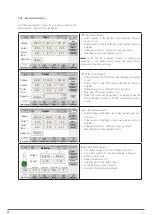
27
In your installation.
–
For greater safety, install the external batteries in a
closed cabinet or in a battery room accessible only
by
qualified
personnel.
Inside the battery cabinet there are accessible
parts with HAZARDOUS VOLTAGE and conse-
quently risk of electric shock, so they are classified
as RESTRICTED ACCESS ZONES. Therefore, the
key of the battery cabinet shall not be available to
the OPERATOR or USER, unless he/she has been
properly instructed or is a
qualified
person. This
cataloging is applicable to battery rooms, regard-
less of whether they can be installed in cabinets
or on a rack.
–
The cabinet is only for sealed maintenance-free
valve-regulated lead-acid batteries. For refillable
lead-acid batteries, they are expected to be in-
stalled on an enabled rack in a specific room.
–
Lead acid battery carries chemical hazards.
–
Reserve a minimum of 1.5 cm between the batteries
and the tray immediately above, allowing free cir-
culation of air around the accumulators. Trays will
be pull-out type to simplify maintenance tasks.
–
When placing batteries in the trays or shelves of
the cabinet or rack, always start at the bottom, in
order to keep the centre of gravity as low as pos-
sible.
–
Avoid sudden impacts and/or vibrations.
–
Avoid cable bending less than 10 cm.
–
Do not cross the battery cables with each other,
they are a risk that can lead to connection errors
with the consequent consequences.
–
The battery connection must be firm and comply
with the tightening torque required by the battery
manufacturer's specifications.
–
Each battery terminal must be isolated after its con-
nection.
–
Do not subject the cables connected to the termi-
nals of the battery to external mechanical stresses
of tension or twisting, as they can damage their
internal connection and in very serious cases ignite.
–
The connection diagram of the batteries is shown
in
.
Precautions in connection.
–
The operations referred to the connection between
accumulators that configure the battery block are
reserved to our
T.S.S.
or in its defect to the dis-
tributor, reason why they are not treated in the user
documentation.
For cabinets where user-owned batteries are in-
stalled, the operations must be carried out and/
or supervised by
qualified
personnel under their
responsibility.
–
Check that the battery
is not
connected or
grounded, as it may cause an electric shock. Other-
wise disconnect the electrical connection.
–
The battery pack can be configured for 32, 36, 40
and 44 12V elements and is calibrated at the factory
with the number of cells according to the battery set
supplied or the number of items requested when the
batteries are owned by the user. If not, 32 elements
[16 + 16]
will be calibrated, with an information
label for the user.
–
The connection of the battery pack to the UPS will
be done before connecting the device to the AC
mains or with the load.
–
DANGER, POTENTIAL OF LETHAL BAT-
TERIES.
Pay attention when handling the
battery connection cables and all parts associated
with them. Terminal block battery voltage greater
than 400 V DC.
–
Inside the battery cabinet there are accessible
parts with HAZARDOUS VOLTAGE and conse-
quently risk of electric shock, so they are classified
as RESTRICTED ACCESS ZONES. Therefore, the key
of the battery cabinet shall not be available to the
OPERATOR or USER, unless he/she has been prop-
erly instructed or is a
qualified
person. This cata-
loging is applicable to battery rooms, regardless of
whether they can be installed or not on a rack.
–
Do not operate the battery mechanisms until indi-
cated.
–
The protection of batteries will always be carried
out at least with fuses and their physical arrange-
ment will be conditioned to the tangible location of
the batteries themselves.
The following are the different assemblies made by
our firm and the location of the battery protection
for each case, which is necessary for the operations
of running and stopping the assembly:
a.
Batteries integrated in the same cabinet as the
device or in its homologous version of “0/” and
“/” in which space is reserved to include them.
b.
Batteries installed or planned to be installed
partly in the own cabinet of the UPS and the
rest in another cabinet or other cabinets or rack.
c.
Batteries installed in one or more independent
cabinets, depending on the requested support
time or “0/” and “/” versions, in which their
backup configuration reserves the necessary
space for the location of the batteries.
–
As a result of the arrangement of the batteries, the
switch and/or the respective protection shall be ar-
ranged as follows and identified in the illustrations
in document EL096*00 according to each case as:
Assemblies type “
a.
”.
1.
Battery disconnect switch, identified as (Q3).
Assemblies type “
b.
” and “
c.
”.
1.
In UPS cabinet. Battery disconnect switch,
identified as (Q3).
2.
In every battery cabinet. Depending on protec-
tion size:
Battery fuse-holder switch with 3 fuses, refer-
enced as (F3).
Or battery disconnect switch, identified as (Q8)
and three internal fuses not accessible to the
user.
SLC ADAPT 2
- UNINTERRUPTIBLE POWER SUPPLY SYSTEM
-
USER MANUAL
Содержание SLC ADAPT2 Series
Страница 1: ...SLC ADAPT2 UNINTERRUPTIBLE POWER SUPPLY USER MANUAL...
Страница 41: ...41 SLC ADAPT 2 UNINTERRUPTIBLE POWER SUPPLY SYSTEM USER MANUAL...
Страница 62: ...62 SALICRU...
Страница 63: ...63 SLC ADAPT 2 UNINTERRUPTIBLE POWER SUPPLY SYSTEM USER MANUAL...





